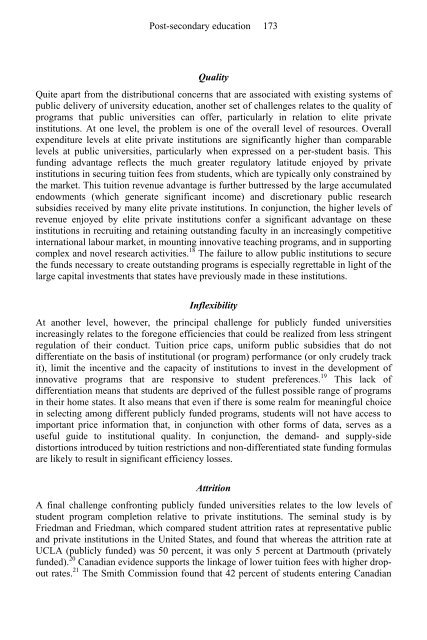Rethinking the Welfare State: The prospects for ... - e-Library
Rethinking the Welfare State: The prospects for ... - e-Library
Rethinking the Welfare State: The prospects for ... - e-Library
You also want an ePaper? Increase the reach of your titles
YUMPU automatically turns print PDFs into web optimized ePapers that Google loves.
Post-secondary education 173<br />
Quality<br />
Quite apart from <strong>the</strong> distributional concerns that are associated with existing systems of<br />
public delivery of university education, ano<strong>the</strong>r set of challenges relates to <strong>the</strong> quality of<br />
programs that public universities can offer, particularly in relation to elite private<br />
institutions. At one level, <strong>the</strong> problem is one of <strong>the</strong> overall level of resources. Overall<br />
expenditure levels at elite private institutions are significantly higher than comparable<br />
levels at public universities, particularly when expressed on a per-student basis. This<br />
funding advantage reflects <strong>the</strong> much greater regulatory latitude enjoyed by private<br />
institutions in securing tuition fees from students, which are typically only constrained by<br />
<strong>the</strong> market. This tuition revenue advantage is fur<strong>the</strong>r buttressed by <strong>the</strong> large accumulated<br />
endowments (which generate significant income) and discretionary public research<br />
subsidies received by many elite private institutions. In conjunction, <strong>the</strong> higher levels of<br />
revenue enjoyed by elite private institutions confer a significant advantage on <strong>the</strong>se<br />
institutions in recruiting and retaining outstanding faculty in an increasingly competitive<br />
international labour market, in mounting innovative teaching programs, and in supporting<br />
complex and novel research activities. 18 <strong>The</strong> failure to allow public institutions to secure<br />
<strong>the</strong> funds necessary to create outstanding programs is especially regrettable in light of <strong>the</strong><br />
large capital investments that states have previously made in <strong>the</strong>se institutions.<br />
Inflexibility<br />
At ano<strong>the</strong>r level, however, <strong>the</strong> principal challenge <strong>for</strong> publicly funded universities<br />
increasingly relates to <strong>the</strong> <strong>for</strong>egone efficiencies that could be realized from less stringent<br />
regulation of <strong>the</strong>ir conduct. Tuition price caps, uni<strong>for</strong>m public subsidies that do not<br />
differentiate on <strong>the</strong> basis of institutional (or program) per<strong>for</strong>mance (or only crudely track<br />
it), limit <strong>the</strong> incentive and <strong>the</strong> capacity of institutions to invest in <strong>the</strong> development of<br />
innovative programs that are responsive to student preferences. 19 This lack of<br />
differentiation means that students are deprived of <strong>the</strong> fullest possible range of programs<br />
in <strong>the</strong>ir home states. It also means that even if <strong>the</strong>re is some realm <strong>for</strong> meaningful choice<br />
in selecting among different publicly funded programs, students will not have access to<br />
important price in<strong>for</strong>mation that, in conjunction with o<strong>the</strong>r <strong>for</strong>ms of data, serves as a<br />
useful guide to institutional quality. In conjunction, <strong>the</strong> demand- and supply-side<br />
distortions introduced by tuition restrictions and non-differentiated state funding <strong>for</strong>mulas<br />
are likely to result in significant efficiency losses.<br />
Attrition<br />
A final challenge confronting publicly funded universities relates to <strong>the</strong> low levels of<br />
student program completion relative to private institutions. <strong>The</strong> seminal study is by<br />
Friedman and Friedman, which compared student attrition rates at representative public<br />
and private institutions in <strong>the</strong> United <strong>State</strong>s, and found that whereas <strong>the</strong> attrition rate at<br />
UCLA (publicly funded) was 50 percent, it was only 5 percent at Dartmouth (privately<br />
funded). 20 Canadian evidence supports <strong>the</strong> linkage of lower tuition fees with higher dropout<br />
rates. 21 <strong>The</strong> Smith Commission found that 42 percent of students entering Canadian


